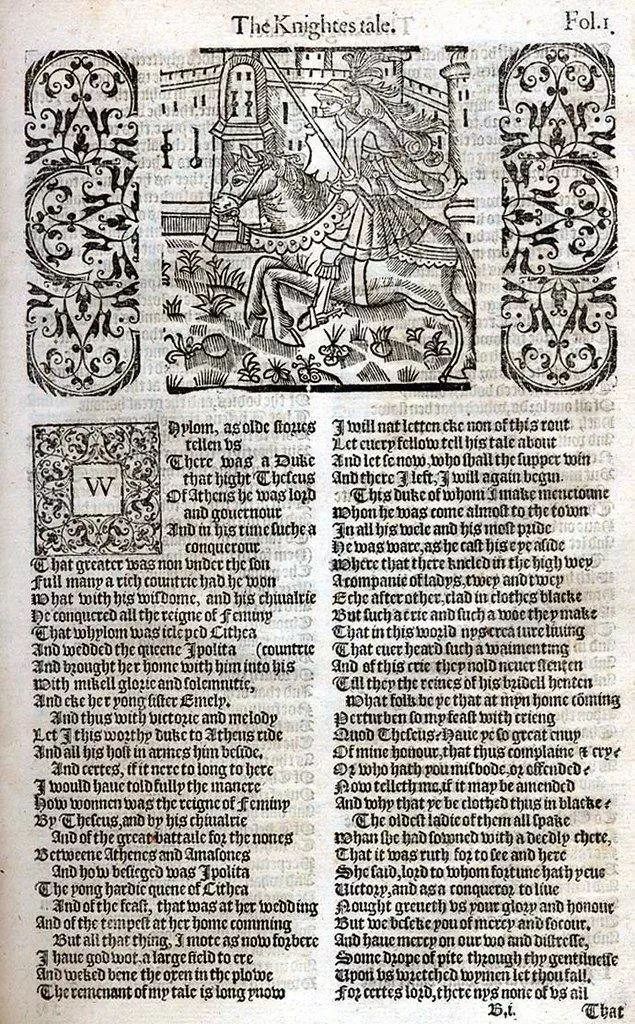Introduction to Middle English
Development of Middle English: Middle English was the form of English spoken in England from the late 11th century to the late 15th century. It was preceded by Old English and followed by Early Modern English. The Norman Conquest in 1066 was the main catalyst in the transition from Old English to Middle English. Prior to the conquest, Anglo-Saxon dialects were spoken in England. After the conquest, the new Norman rulers introduced French as the language of government and the upper classes. As a result, English absorbed thousands of French words, which began to change the grammatical structure and vocabulary of the language. By the 14th century, Middle English had become the dominant literary language. Some key developments included:
- Loss of grammatical gender
- Simplification of grammar
- Disappearance of Old English inflections
- Increase in vocabulary as English absorbed French, Scandinavian, and Latin words
- The emergence of Geoffrey Chaucer as a masterful English poet at the end of the Middle English period
Middle English covers works like The Canterbury Tales, Piers Plowman, and Sir Gawain and the Green Knight. It represents a transition between the highly inflected Old English and the analytic Early Modern English that followed. The Norman Conquest accelerated this linguistic evolution by introducing French influence.
Development of Middle English
The Norman Conquest in 1066 CE marked a major turning point in the development of the English language. With the arrival of the Normans, the English language incorporated many words from Norman French and Latin. Norman scribes also introduced new spelling conventions that made English spelling increasingly inconsistent 1.
The influence of Norman French led to a significant infusion of French vocabulary into English. Words like “government,” “justice,” and “parliament” entered the language during this period. Latin also became increasingly important in English for scholarly and religious vocabulary. As a result, English adopted words like “disciple,” “infant,” and “creator.”
In addition to changes in vocabulary and spelling, Middle English saw the emergence of regional dialects. The North and West Midlands retained more Old English influence, while the East Midlands had greater Norman influence. The London dialect emerged as the prestige dialect and formed the basis of standard Modern English. However, many dialectal variations persisted.
Pronunciation also underwent substantial changes in Middle English. The vowels shifted, leading to the Great Vowel Shift that marked the transition to Early Modern English. Consonants like /k/ and /g/ became softened, while double consonants simplified to single consonants. These phonetic changes made Middle English almost unintelligible to speakers of Old English.
The Norman Conquest catalyzed sweeping changes in English, laying the foundation for the evolution into Modern English. From vocabulary to pronunciation, Middle English represented a radically transformed language that still retained its Germanic roots.
Early Middle English Literature
The epic poem Beowulf is one of the most notable works from the Early Middle English period. Composed in Anglo-Saxon, the earliest form of English, Beowulf tells the story of a Scandinavian hero who defeats three separate monsters [1]. The poem provides a window into pagan legends and heroic tales from this era.
Linguistically, Beowulf demonstrates key features of Old English including its Germanic roots and inflections. The vocabulary and syntax are vastly different from Modern English. For example, swa þeah maga mannes cunne side oþþe sundor ætbrecan worde ond on wille (“nevertheless in some way son of man can relate matter widely and individually shatter words and intentions”) [2].

Other important early Middle English works include The Peterborough Chronicle, a historical account of events in England from the time of Julius Caesar to the 12th century. The Anglo-Saxon Chronicle was initially written in Old English and later continued in early Middle English [3]. These chronicles provide insights into the evolution of the English language.
The Flowering of Middle English Literature
The 14th century marked a major flowering in the development of Middle English literature. This period saw Geoffrey Chaucer emerge as the preeminent English poet of his time, with his masterpiece The Canterbury Tales becoming one of the first works widely recognized as great literature in the English vernacular [1].
Chaucer made invaluable contributions to the standardization of written Middle English during this period. Prior to Chaucer, Middle English varied widely in dialect and spelling. In The Canterbury Tales, Chaucer helped popularize the London dialect of Middle English as the language’s literary standard. His works also helped expand the English vocabulary by introducing new words adapted from French and Latin [2].
Geoffrey Chaucer (c. 1343-1400) was born in London to a prosperous wine merchant family. He spent most of his adult life in service of the English court, traveling abroad on diplomatic missions and working in a variety of administrative roles. Chaucer began writing poetry in the 1330s and would go on to produce some of the most influential works of Middle English literature [3].
His masterpiece, The Canterbury Tales, was likely begun in the late 1380s and left unfinished at his death in 1400. The work consists of a collection of stories told by pilgrims on their journey to visit the shrine of Thomas Becket at Canterbury Cathedral. The narratives range widely in tone and subject matter, from courtly romance to earthy comedy. The skillful character portraits and mix of styles helped establish Chaucer as the preeminent storyteller of his age.
The Canterbury Tales stands as a crucial literary achievement that helped shape the future development of English literature. Chaucer’s use of vernacular Middle English at a time when Latin and French were dominant made the work enormously influential. By telling his stories in the language of the people, Chaucer helped elevate the literary prestige of English. The Canterbury Tales also popularized the use of iambic pentameter in Middle English poetry, a verse form that became a staple of English literature.

In his poetry and other works, Chaucer introduced many words and phrases from French and Latin that entered common usage in English. His writings served as an early model of literary English at a formative time for the language. Geoffrey Chaucer’s contributions helped pave the way for the flourishing of Renaissance literature in Early Modern English led by Shakespeare and others a few centuries later.
Later Middle English and Transition to Early Modern English
The 15th century saw significant changes to the English language that marked the transition from Middle English to Early Modern English. One major development was the Great Vowel Shift, which began around 1400 and continued well into the 16th century. This involved a radical change in pronunciation of all the long vowels, which shifted to become more modern sounding.
Another factor that shaped the transition to Early Modern English was the introduction of the printing press to England by William Caxton in 1476. This helped standardize spelling and grammar and exposed readers to works in a unified form of English rather than regional dialects.
In terms of literature, later Middle English works like Thomas Malory’s Le Morte d’Arthur (c.1470) were important in establishing English as a literary language. This work compiled tales of King Arthur and his knights in a vivid English prose style. Other notable late Middle English works were The Canterbury Tales by Geoffrey Chaucer and Sir Gawain and the Green Knight. These began using forms of English that were moving closer to Modern English.
By the end of the 15th century, the language started to resemble what we identify today as Early Modern English. This variety started becoming widely used in the 16th century and set the stage for the works of the Elizabethan era, including those by William Shakespeare.
Conclusion
The Middle English period lasted from around 1100-1500 AD and marked a transitional phase between Old English and Early Modern English (Wikipedia). Over the 300-400 years of the Middle English period, the language underwent dramatic changes in vocabulary, pronunciation, and grammar under the influences of the Norman conquest and increasing contact with French and Latin (OED).
Early Middle English retained some characteristics of Old English but already showed considerable French influence. The later part of the Middle English period saw continued assimilation of French and Latin words and the almost total loss of inflections. By the end of the period, Middle English had largely transitioned into the Early Modern English of Shakespeare and others. The Norman conquest marked the beginning of Middle English’s evolution away from highly inflected Old English; this simplification of grammar and increase in borrowed vocabulary had long-lasting impacts that are still evident in modern English today (Britannica). Overall, the Middle English period represents a transformative phase in the history of the English language.



2 Comments
Pingback: Mastering Anglo-Saxon Literature: 5 Fascinating Insights into Beowulf and Anglo-Saxon Texts - LitGram by MukeshRishit
Pingback: A Prayer for Owen Meany by John Irving: 10 Profound Life Lessons - LitGram by MukeshRishit